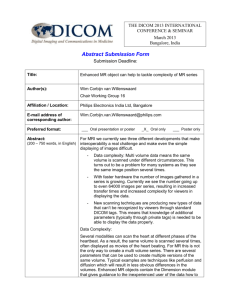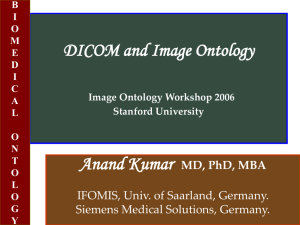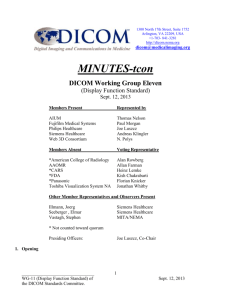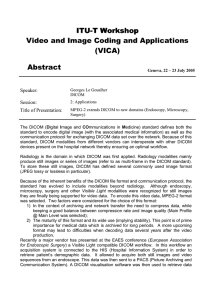AN APPROACH TO THE STORAGE OF DICOM FILES
advertisement
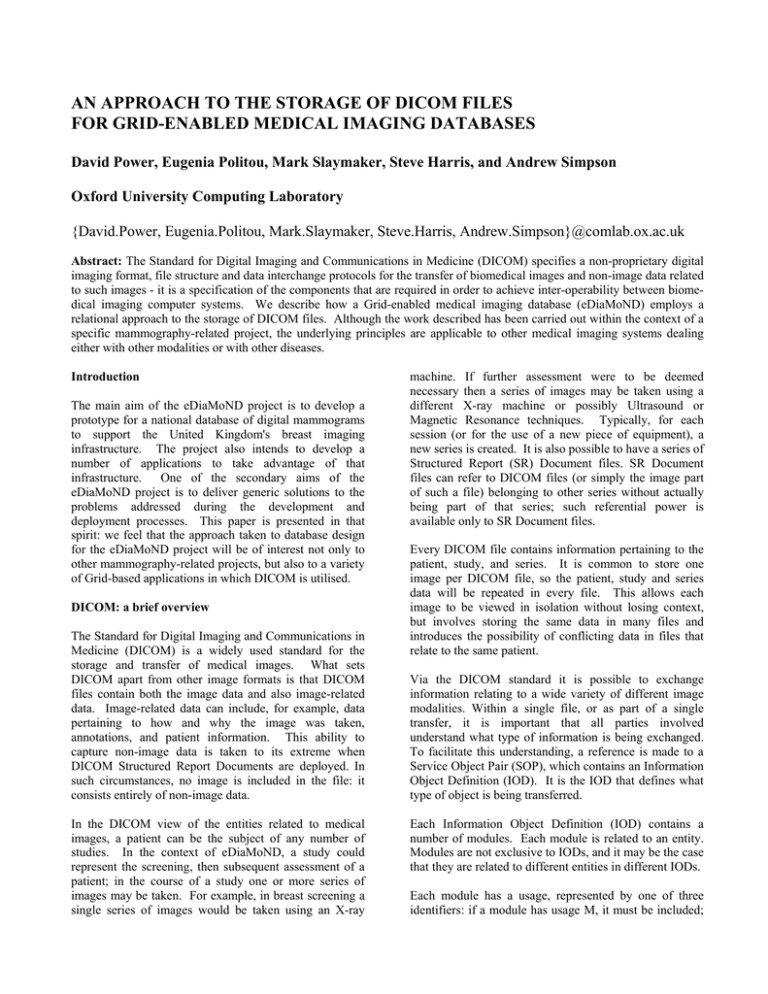
AN APPROACH TO THE STORAGE OF DICOM FILES
FOR GRID-ENABLED MEDICAL IMAGING DATABASES
David Power, Eugenia Politou, Mark Slaymaker, Steve Harris, and Andrew Simpson
Oxford University Computing Laboratory
{David.Power, Eugenia.Politou, Mark.Slaymaker, Steve.Harris, Andrew.Simpson}@comlab.ox.ac.uk
Abstract: The Standard for Digital Imaging and Communications in Medicine (DICOM) specifies a non-proprietary digital
imaging format, file structure and data interchange protocols for the transfer of biomedical images and non-image data related
to such images - it is a specification of the components that are required in order to achieve inter-operability between biomedical imaging computer systems. We describe how a Grid-enabled medical imaging database (eDiaMoND) employs a
relational approach to the storage of DICOM files. Although the work described has been carried out within the context of a
specific mammography-related project, the underlying principles are applicable to other medical imaging systems dealing
either with other modalities or with other diseases.
Introduction
The main aim of the eDiaMoND project is to develop a
prototype for a national database of digital mammograms
to support the United Kingdom's breast imaging
infrastructure. The project also intends to develop a
number of applications to take advantage of that
infrastructure.
One of the secondary aims of the
eDiaMoND project is to deliver generic solutions to the
problems addressed during the development and
deployment processes. This paper is presented in that
spirit: we feel that the approach taken to database design
for the eDiaMoND project will be of interest not only to
other mammography-related projects, but also to a variety
of Grid-based applications in which DICOM is utilised.
DICOM: a brief overview
The Standard for Digital Imaging and Communications in
Medicine (DICOM) is a widely used standard for the
storage and transfer of medical images. What sets
DICOM apart from other image formats is that DICOM
files contain both the image data and also image-related
data. Image-related data can include, for example, data
pertaining to how and why the image was taken,
annotations, and patient information. This ability to
capture non-image data is taken to its extreme when
DICOM Structured Report Documents are deployed. In
such circumstances, no image is included in the file: it
consists entirely of non-image data.
In the DICOM view of the entities related to medical
images, a patient can be the subject of any number of
studies. In the context of eDiaMoND, a study could
represent the screening, then subsequent assessment of a
patient; in the course of a study one or more series of
images may be taken. For example, in breast screening a
single series of images would be taken using an X-ray
machine. If further assessment were to be deemed
necessary then a series of images may be taken using a
different X-ray machine or possibly Ultrasound or
Magnetic Resonance techniques. Typically, for each
session (or for the use of a new piece of equipment), a
new series is created. It is also possible to have a series of
Structured Report (SR) Document files. SR Document
files can refer to DICOM files (or simply the image part
of such a file) belonging to other series without actually
being part of that series; such referential power is
available only to SR Document files.
Every DICOM file contains information pertaining to the
patient, study, and series. It is common to store one
image per DICOM file, so the patient, study and series
data will be repeated in every file. This allows each
image to be viewed in isolation without losing context,
but involves storing the same data in many files and
introduces the possibility of conflicting data in files that
relate to the same patient.
Via the DICOM standard it is possible to exchange
information relating to a wide variety of different image
modalities. Within a single file, or as part of a single
transfer, it is important that all parties involved
understand what type of information is being exchanged.
To facilitate this understanding, a reference is made to a
Service Object Pair (SOP), which contains an Information
Object Definition (IOD). It is the IOD that defines what
type of object is being transferred.
Each Information Object Definition (IOD) contains a
number of modules. Each module is related to an entity.
Modules are not exclusive to IODs, and it may be the case
that they are related to different entities in different IODs.
Each module has a usage, represented by one of three
identifiers: if a module has usage M, it must be included;
if it has usage C, its inclusion will depend on an explicit
condition; if it has usage U, it is optional.
modalities will not pose any implementation issues (at the
database level, at least).
Each module is made up of a number of attributes. Each
attribute has a name, a tag and a type. The tag is a pair of
16 bit numbers used to identify the attribute. The first
number signifies the Tag Group that the attribute belongs
to; the second number identifies the Tag Element.
Together, the pair represents the specific attribute. Even
for mandatory modules it is not necessary to use all the
attributes. The type of the attribute determines if it must
be present and whether it must contain any data: type 1
attributes must be present and contain data; type 2
attributes must be present but may contain no data; type 3
attributes are optional. Type 1C and 2C attributes also
exist: such attributes are present only if certain conditions
are met. It is possible that attributes may be present in
more than one module; in this case the attribute may have
more than one type. In these cases the most restrictive
type is used.
Standard sets of patient data forms are gathered at the
same time as image acquisition. Screening forms are
stored as DICOM Structured Report Documents, which
contain standard BiRADS classifications.
Data requirements
In this section we describe some of the types of data that
we are concerned with.
The IODs currently supported by the eDiaMoND system
are those pertaining to Secondary Capture Images, Digital
Mammography X-Ray Images, and Mammography CAD
Structured Report Documents. It is fully intended that
future versions of the database will support other
modalities, such as Magnetic Resonance Images,
Ultrasound Multi-frame Images, and Positron Emission
Tomography Images.
The eDiaMoND database is
designed in such a way that the addition of further
Design
Users are not permitted to query the database directly,
instead queries are sent in a pre-determined format as
XML documents to the Query Service.
The Query Service, as illustrated in Figure 1, communicates with the database through an OGSA-DAI Grid
Data Service. The Query Service can determine the
access rights of an individual user by querying the
database as a privileged user. Having determined the
appropriate access permissions, the query is either
rejected or translated into appropriate SQL. The Query
Service also ensures that the access attempts are logged
correctly by inserting the user details into the logs.
XML Document
XML Document
Authentication
Access Control
Audit Control
Query Service
OGSA-DAI
Request Document
Log Generation
OGSA-DAI
Result Document
Translation:XML->SQL
Translation:SQL->XML
OGSA-DAI
Grid Data Service
JDBC
Having a value multiplicity of more than one allows
simple lists of attributes; for more complicated repeated
patterns of attributes, DICOM defines sequences. A
particular attribute may be present in many different
sequences and many times in a particular sequence. It is
also possible for sequences to contain other sequences.
While this might tend to suggest that an object-oriented
approach to the design of the database would be appropriate, the drawbacks associated with object-oriented
databases, such as, for example, the fact that query
optimisation compromises encapsulation means that an
object-relational approach is more appropriate. The IBM
DB2 database - which underpins eDiaMoND - offers such
capabilities.
All updates to the database take the form of DICOM files
inserted into the database. The non-image components of
these files are stored in the database, together with an
identifier pertaining to the user that inserted the DICOM
file, as well as additional information, such as, for
example, the time that the file was inserted. The database
also keeps a record of all queries on the data.
JDBC
In Part 6 of the DICOM standard, each tag is given a
value representation (VR) and a value multiplicity (VM).
The value representation describes the exact binary
representation of the attribute within a DICOM file. The
value multiplicity gives the number of such attributes.
There are, of course, other types of information to be
captured by the database. Data pertaining to audit trail
and access control capabilities are of particular relevance,
given the nature of eDiaMoND. In particular, there is a
clear need to have a sufficiently flexible access control
mechanism to allow individual hospitals or departments
to enforce their own local policies. These issues are,
however, outside the scope of this paper.
Database
....
Figure 1. Grid Query Service Architecture
The JDBC connection is made to a single logical database
- although, in reality - this will be either a federation of
different physical databases or a group of replicated
databases. The design supports the querying of both.
While it is desirable to be able to handle all types of
DICOM files, it is not practicable to create a normalised
database that could fully represent an arbitrary file. This
problem can be easily understood if the system was
required to deal with a new version of DICOM, which
perhaps introduced new data fields or new IODs. In
effect, we are designing for forwards-compatibility. In
addition, employing an unnormalised structure - with the
potential performance benefits that may result - is
inappropriate for an application that requires guaranteed
consistency of data; data integrity is essential for an
application such as eDiaMoND. Despite the fact that it is
undoubtedly the case that performance is important to us,
delivering correct data in a longer time is infinitely more
preferable than delivering incorrect data quickly.
For these reasons we divide the eDiaMoND database
logically into two parts, as illustrated in Figure 2.
CLINICAL INFORMATION STORE
REPOSITORY
Left Side
Right Side
DICOM file
Figure 2. Database Architecture
In one logical part of the database - which we term the repository - the data is stored in a relatively unstructured
fashion. In the other part - which we term the clinical
information store - data from specific IODs can be stored
in a high-order relational database (at least 3NF). In this
way, when a DICOM file is inserted, it is parsed, with all
non-image data being stored in the repository. Then,
automatically, via automated constraint-enforcing
procedures (triggers), the necessary data is inserted into
the clinical information store. It is noted that in the
repository, all the tags of the DICOM file are stored,
including optional and private tags. In contrast, the
clinical information store holds only the data that is
currently useful for eDiaMoND applications. If any tags
were to be deemed relevant in future, it would be trivial to
create additional relevant triggers.
In this architecture there are some rules that have to be
obeyed. First, the repository allows only INSERTs, but
not UPDATEs or DELETEs; this ensures that there is no
potential for data loss. Second, the clinical information
store allows only INSERTs and UPDATEs as a result of
INSERTs to the repository; this ensures that the data in
the clinical information store is consistent with that in the
repository.
One of the most critical issues when developing a medical
database is the provision of appropriate mechanisms for
allowing updates and tracking changes. This importance
is derived from the legal and ethical requirements to
record all updates of patient and screening data. In the
eDiaMoND database, the deletion of previously captured
DICOM files is forbidden. The principal reasons for this
are the necessity for keeping a history of previous data
and cooperating with the existing health and legal
regulations.
When an update of information is needed, e.g., a change
of name or a change of address, this will take place as a
two-phase operation. The first phase involves the
insertion of a new DICOM file that contains the updated or corrected - data. The second phase - which is triggered
by the successful completion of the first phase - involves
a copy and an update.
This second phase of the update mechanism is described
by the following example, which is depicted in Figure 3.
We consider a patient - Helen Jones - who has a unique
ID: 12. Associated with this record is a related record referenced by a foreign key called Audit Index - in another
table, called Audit Table, which records the "who", the
"when", and the "where" corresponding to the creation of
a record in the Patient Table. If the patient were to get
married, with a consequent change of surname, we would,
of course, wish to update the patient's name, with all other
pertinent information remaining the same. To achieve
this, the patient record in Patient Table has to be
duplicated, resulting in a new record, with a primary key
of 13. The information contained in the fields of the old
record, having a primary key of 12, will remain the same,
except the one that has to change, which in our case is the
Name field, and also the field called Audit Index. The
latter has to reference a new record in Audit Table, which
will contain all the necessary information pertaining to the
conditions under which the alteration has taken place.
This new record is the one having primary key 1043 in
the Audit Table. In the above example we have used one
Audit Table for a given table in the database. However,
one Audit Table can be used to track the changes of many
tables.
The concept remains the same: the only
modification is the addition of another field in the Audit
Table containing a reference to the table that has been
changed.
BEFORE UPDATE
AFTER UPDATE
Patient Table
PK
12
Patient Table
Name
Parent Index Audit Index
Jones Helen
NULL
879
Name
Parent Index Audit Index
12
Lloyd Helen
NULL
1043
13
Jones Helen
12
879
Audit Table
Audit Table
PK1 Res.Person Date/Time
879
PK
2002:2:75:23:03:786476
Dr. Miller
Reason
Insertion
Place
PK1
John Radcliffe
Hospital
Res.Person Date/Time
Reason
Place
879
Dr. Miller
2002:2:75:23:03:786476
Insertion
John Radcliffe
Hospital
1043
Dr. Baker
2003:12:208:20:32:700346
Marriage
Churchill
Hospital
Figure 3. An Update
The schema for the clinical information store has been
designed in a way that allows an arbitrary set of DICOM
files to be stored in the database, while ensuring that the
relationships between Patients, Studies, Series and
Equipment is maintained.
IOD_1_Patient_Attrib.
Patient_Entity
eDiaMoND_Patient_Information
1
IO
D_
1_
Eq
uip
me
nt_
Attr
ib.
IO
D_
2_
Eq
uip
me
nt_
Attr
ib.
IO
D_
3_
Eq
uip
me ......
nt_ .
Attr
ib.
IOD_2_Patient_Attrib.
1 PK Patient_UID: INTEGER
1
1
0..1
IOD_3_Patient_Attrib.
.......
0..*
IOD_1_Study_Attrib.
Study_Entity
PK
FK
IOD_2_Study_Attrib.
Study_Instance_UID: CHAR(64)
1
Patient_UID: INTEGER
0..1
1
IOD_3_Study_Attrib.
.......
The Patient Entity table is also linked to the
eDiaMoND_Patient_Information table; this contains the
additional patient data that was described previously,
which is essential for epidemiology and integration with
existing patient record systems.
The entity spine contains a bare minimum of data
allowing efficient querying when using Unique Identifiers
(UIDs). The Patient_UID and Equipment_UID are not
part of the DICOM standard. The Patient_UID is
represented as the Patient_ID attribute in the DICOM
files, as an additional requirement on the users of the
eDiaMoND system it is essential that all Patient_IDs are
unique. The Equipment_UID is stored in the Device
Serial Number attribute, and is also unique.
0..*
Series_Entity
1
0..1
Equipment_Entity
1
PK Equipment_UID: INTEGER
IOD_1_Series_Attrib.
PK Series_Instance_UID: CHAR(64)
IOD_2_Series_Attrib.
FK Study_Instance_UID: CHAR(64) 1
IOD_3_Series_Attrib.
FK Equipment_UID: INTEGER
0..1
.......
0..*
1
1
0..*
0..*
Image_Entity
SR_Document_Entity
PK SOP_Instance_UID: CHAR(64)
FK Series_Instance_UID: CHAR(64)
PK SOP_Instance_UID: CHAR(64)
FK Series_Instance_UID: CHAR(64)
1
1
0..1
IO
D_
1_I
ma
ge_
Attr
ib.
As mentioned previously, the modules of an IOD are all
related to specific entities. Those modules contain
attributes that may be present in more than one module,
however the structure of DICOM is such that the same
attribute will not be present in more than one entity. For
this reason it makes more sense to group the attributes of
an IOD by entity and not by module. Although not shown
in the diagram, the tables relating to each IOD are linked
to the entity tables by a shared primary key, for example,
the IOD_Image_Attrib table has a primary key of
SOP_Instance_UID, which has a foreign key constraint to
the SOP_Instance_UID primary key of the Image_Entity
table.
0..1
IO
D_
3_I
ma
ge_ ......
Attr .
ib.
IO
D_
2_
SR
_At ......
trib. .
Figure 4. DICOM Data Schema
The schema of Figure 4 is logically divided into two
parts: there is the common spine of DICOM entities and
additional tables relating to specific IODs. In the diagram, three IODs are represented: IOD_1 and IOD_3
represent two different types of DICOM image IODs,
while IOD_2 represents a Structured Report IOD. While
all three IODs have attributes related to Patient, Study,
Series and Equipment, only the Image IODs have
attributes related to the Image entity and only the
Structured Report IOD has attributes related to the
Document entity.
Discussion
We have described an approach to the storage of DICOM
files that has been taken in the development of a Gridenabled medical image database. As DICOM is a widely
recognised standard for the transfer and storage of
medical images, the applicability of the approach is by no
means restricted to the area of mammography.
Furthermore, even though the eDiaMoND database is
based on IBM's DB2 and Content Manager technologies,
there is nothing vendor-specific about the principles that
have been employed.
The database has been designed with the storage of any
class of DICOM file in mind: although we have restricted
ourselves only to IODs of relevance to eDiaMoND, the
database has been designed so that it can easily be
adapted to handle other types of file or other IODs. This
design decision was taken with the view of futureproofing the system: new epidemiological studies, new
equipment and new reporting forms all have the potential
to introduce new types of data into the database. The
logical divide of the database into the clinical information
store and repository means that one part can easily be
restructured without there being the potential for major
disruption to the system as a whole.
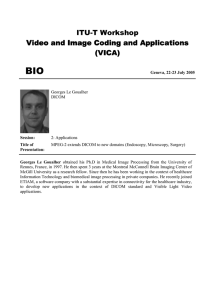


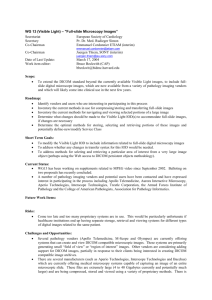
![[#MIRTH-1930] Multiple DICOM messages sent from Mirth (eg 130](http://s3.studylib.net/store/data/007437345_1-6d312f9a12b0aaaddd697de2adda4531-300x300.png)
